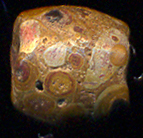
IV 1 - 10 * 10 mm
SOLD |
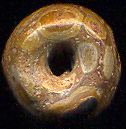 |
Eye bead
made of
orbicular jasper. Look in the
eye bead
section
to see the bead from another angle.
|
|
|
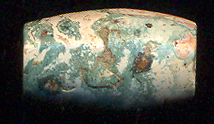
IV 2 - 14 * 9 mm
Price: 800 usd |
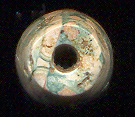 |
An almost abstract painting in green,
rose, and white colors.
Indus Valley beads were the
first
to demonstrate abstract
art in the world!
|
In these
extraordinary, ancient Indus beads, one can often find what is
referred to as variegated
Jasper. This
type of Jasper includes up to 20 percent non-quartz elements,
accounting for the broad range of colors and decorative patterns
observed.
Variegated Jasper was a highly prized gemstone among the people
of the Indus Valley and Mesopotamia. However, you will also find
an array of truly unique types of Agate featured in this Indus
collection.
A common feature of these beads is their symmetry, which often
plays a significant role in the choice and creation of patterns.
You may also frequently find the
golden ratio
reflected in the patterns. In the
Magic Eye Beads,
for example, the eye is almost invariably situated at the
symmetrical center or within the golden ratio positioning.
A distinguishing characteristic of these Agate and Jasper beads
is their extraordinary variety of colors and unusual mineral
'landscapes'. They represent a quest for the perfect bead,
constructed from the most sublime materials.
These beads are assembled works of art, revealing the intrinsic
beauty of their stone patterns through the craftsmanship of
their creators. They embody the human aspiration to conceive and
realize beauty. These beads, which emerged from raw stone
approximately 3000 years ago, continue to captivate observers as
they are displayed on this page.
|
|
|
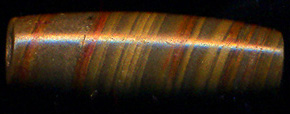
IV 5 - 23 * 7 mm
Price: 1000 usd
|
 |
A tubularly shaped jasper bead with
3-colored spiral
motif.
The banding lines are 'composed' in a very harmonious way in this incredible bead.
|
|
Believing that the sculpture was waiting inside the stone for
the artist to free it, these ancient craftsmen knew the
art of letting the different natural
motifs of the agate
show itself at its finest!
Great care has been taken in cutting many of these
stones so as to get special effects from the natural
structure of the stone, white or colored bands being
arranged to form 'eyes' , 'zones' or chevrons, all of
which may have had special meanings. (Beads
from Taxilla,
Horace Beck - p.8)
|
|
|
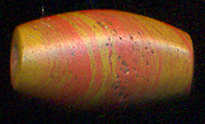
IV 6 -
14 * 8 mm
Price: 900 usd |
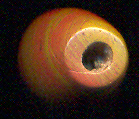 |
A beautiful and very rare color combination of yellow and red
in this unique jasper bead. It seems that red stripes and dots
were the Indus peoples favorite. At least I have not seen beads
with so
many red colored motifs as in this collection from
this Rakhigarhi Indus Valley collection.
|
|
Time is love
Due to modern technology and the general acceleration of social
interaction on all levels in our modern time, it takes only five
hours to produce a bead. In the app Big Data, it is
mentioned that we today experience and process as much
information in one day as we did in an entire lifespan 500 years
back. So when it is estimated that it would take around
1 or 2 weeks to make a bead with Indus technology, we here have
to add the general historical acceleration of time to the
equation.
To sum it up: Magic beads are made in ample time ... Time is
love
The outstanding bead for the outstanding personality
For me all the above-mentioned characteristics point in one
direction. They hint at an interest in individuality.
The interest in the outstanding bead reflects the awareness that
individuals stand apart from each other and are
unique in their own right.
Seen from a historical point of view
the discovery of the individual is a modern
phenomenon.
We only find the notion of individuality in advanced societies
and hence only in rare cases
in ancient civilizations.
|
|
|
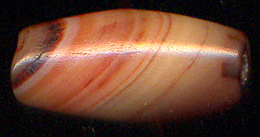
IV 8 - 20 * 10 mm
Price: 1000 usd
|
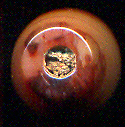 |
|
|
A quick comparison to the culture of DZI beads makes my point
stand more clear: The DZI-beads are much
more uniform.
They reflect, not individuality, but 'typification'. DZI is
reflecting, not individuality,
but standard behavior patterns.
I do believe that the late Indus culture, not in its beginning
in the West in what is now Pakistan,
but in it's very
blossoming
end in North India, did in fact discover the individual man!
The beads displayed here bears testimony to this belief. They
are the Rolex watches of the late Indus culture.
|
|
|
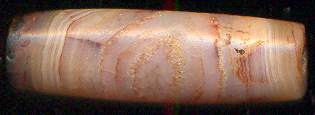
IV 9 - 25 * 8 * 7 mm
Price: 1000 usd |
 |
A tubularly shaped
agate bead with a soft
rose colored motif.
The eye formation in the middle is less visible.
|
|
Beads as currency & magic talismans
In the Indus Valley civilization, it is easy to assume that beautiful beads had a symbolic religious
function that reached into the sphere of trade. Beads would
fulfill the same function as later coins would.
However, the primary function most probably was to protect the
wearer from evil eyes and predatory entities
in an animistic world consisting of many layers of reality
reaching from gross existence to spirit dimensions.
|
|
|
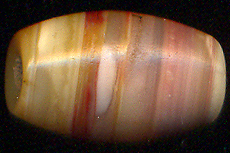
IV 10 - 17 * 11 mm
Price: 1000 usd
|
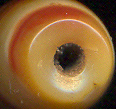 |
This stunning bead reminds me of
pictures of Saturn.
Beads are frozen landscapes. SOLD |
|
In the historical periods to follow the Indus culture beads started to lose their importance as currency
and
signifiers of high social status. The relatively high and well ordered
social organization of Kingdoms made
the controlled
mass production of coins possible and diamond drills made it more
easy to mass produce beads.
A bead does not possess the same
quantifiable quality as a coin produced
by a certain Kingdom, and
this even more so if the bead mirrors the need for
individuality.
|
|
|
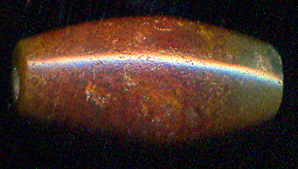
IV 11 - 21 * 11 mm
- SOLD |
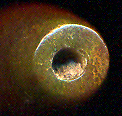 |
Jasper bead.
A complimentary, golden angle
color composition in red and green. |
|
In contrast to a coin, the value is of a certain bead can always be
argued. Maybe it was the transition from
bead currency to money currency that created the need for
uniform beads such as the Tibetan DZI with a
hierarchy
of eyes and the Pyu beads with the so-called military stripes.
However, if the beads lost their importance
as currency and social signifiers,
they at least in the east never lost their importance as
magic totems!
In this context one should not forget that the practice of
meditation most probably was
founded by the Indus civilization.
|
|
|
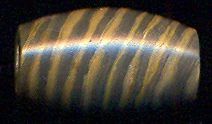
IV 12 - 15 * 10 mm - SOLD |
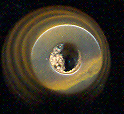 |
A beautiful and calm composition
in
a spiral striped bead. |
|
|
|
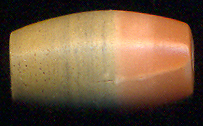
IV 14 - 16 * 9 mm
Price: 800 usd
|
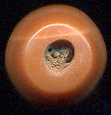 |
A color
composition in soft red
and green. |
|
|
|
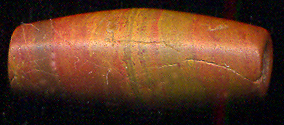
IV 15 - 21 * 9 mm
Price: 800 usd
|
 |
Soft yellow and rose colors spiral their way round this bead. As said before: these old artists have composed these beads. They are ancient masterpieces of art. |
|
|
|
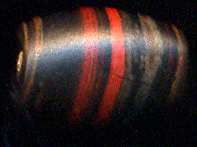
IV 16 - 14 * 10 * 9 mm
SOLD
|
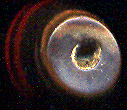 |
Red and black banded agate
are extremely rare. This natural color combination has never been seen before! Maybe these two beads are the only of their kind
who has 'survived' up till today.
Not for sale, unless 'insane' price is offered. |
|
|
|
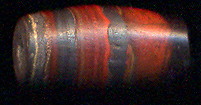
IV 17 - 13* 8 mm
SOLD |
 |
The red color in this fantastic agate bead
looks almost like it has been etched into the stone. However, it
is natural. |
|
|
|
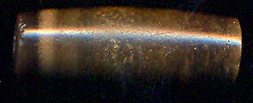
IV 18 - 19 * 6 mm
Price: 600 usd
|
 |
Eye bead - This is the back side of the bead.
Look in the
eye bead
section to see the front side. |
|
|
|
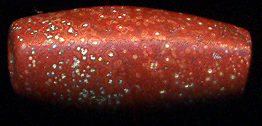
IV 19 - 22 - 20 * 9 mm
Price: 800 usd
|
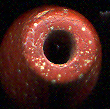 |
I think this incredible bead is made out of fossilized
Jasper. The Indus people loved to make beads out of rare materials. |
|
|
|
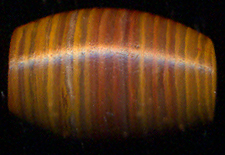
IV 20 - 18 * 11 mm
SOLD
|
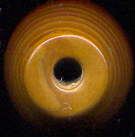 |
In this bead the bands of red, yellow and brown are very thin. |
|
|
|
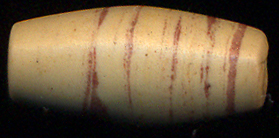
IV 21 - 22 * 11 mm
Price: 800 usd
|
 |
|
|
|
|
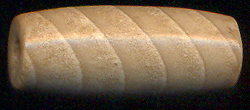
IV 22 - 18 * 8 mm
Price: 800 usd |
 |
|
|
|
|
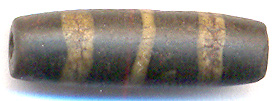
IV 23 - 19 * 11 * 10 mm
- SOLD |
 |
In this bead it becomes clear that
the etched beads in the beginning very designed
to copy the original stripes.
It is strange that today's
collectors prefer the etched 'copies'. |
|
|
|
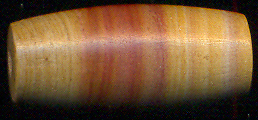
IV 24 - 20 * 10 mm
Price: 800 usd
|
 |
|
|
|
|
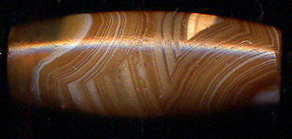
IV 25 - 23 * 9 mm
Price: 1200 usd
|
 |
This agate bead is like an
abstract painting. Just love it! |
|
|
MAGIC HYBRID INDUS-MAURYAN
BEADS?
The Indus civilization
began to decline around 1900 BC, most likely due to a
significant earthquake that redirected the course of
multiple rivers that had once rendered this area one of
the most fertile regions on the planet. However, the
eastern and southern coastal parts of the Indus culture
managed to endure for a more extended period. In India,
particularly in Gujarat and Haryana, the Indus
civilization continued until about 1300 BC, and in some
isolated pockets such as
Pirak,
it likely persisted much longer. Harvard archaeologist
Richard Meadow highlights the late Harappan
settlement of Pirak, which endured up to the time of
Alexander the Great's invasion in 325 BC.
Discoveries of an
Indus
site in Maharashtra suggest that this remarkable
civilization expanded into the
Deccan
plateau in its later period. It even appeared to
reach
Uttar Pradesh on the Gangetic plain like a fading
wave.
In these more eastern regions, the Indus civilization
likely merged into what is termed the
Classic historic period of India, beginning around
200 BC. My theory is that in these and other isolated
regions in India, parts of the craftsmanship and culture
of the Indus people were passed down to classical India,
thereby allowing them to continue evolving.
|
|
|
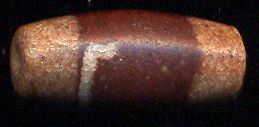
IV 26 - 19 * 9 mm
Price: 1300 usd
|
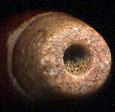 |
Man made or natural
motif? |
|
|
In what is
often referred to as the
mature Harappan period,
from 2600 to 1900 BC, the art of beadmaking reached its
zenith. Since then, with a few exceptions, this art form
has been in a gradual decline. Rakhigarhi might
represent one of these exceptions. Some of the most
beautiful beads, in my opinion, originate from this
region, and you can see them displayed here! It's
plausible that in Rakhigarhi, the art of the Indus bead
masters survived beyond their own civilization for
thousands of years, and reached a new peak by merging
with the much later
unique Mauryan stone polishing techniques. The way
the beads displayed below are polished is simply
sublime! In my view, they are better polished than
traditional Indus Valley beads. However, I leave it to
you to decide on this assertion.
As Horace Beck points out in his book, "Beads from
Taxila", it's not uncommon to find much older and
already used beads showing significan**t wear in Buddhist
relic caskets. If these beads are significantly older
than the Buddhist period in India, they're most likely
Indus beads. What does the use of much older Indus beads
in these caskets signify? It illustrates that beads were
treasured in an unbroken, continuous tradition,
extending from the enigmatic Indus culture into the
emerging empires of Chandragupta Maurya and his Buddhist
grandson, Ashoka the Great.
|
|
|
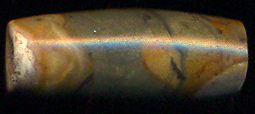
IV 27 - 20 * 8 mm
Price: 900 usd |
 |
|
|
|
Indeed,
it's worth remembering that without Ashoka's influence,
Prince Siddharta (also known as Buddha) could have
remained a local spiritual leader among the many
'Buddhas' who meditated in the prosperous and highly
urbanized Gangetic plain of that time.
The beads displayed on this page, therefore, might not
necessarily be from the mature
Mauryan period,
but could instead be Buddhist/Jain beads from the much
later Mauryan period. Given that Haryana remained a
vibrant urban area until around 100 AD, such a
hypothesis could be plausible. If that were the case -
and I concede this is purely speculative - these beads
would incorporate two of the greatest peaks of Indian
civilization: the Indus Valley and the Mauryan periods!
Such a blend of cultural influences in these artifacts
would serve to highlight the deep history of
craftsmanship in India and the continuity of artistic
traditions across different epochs and dynasties.
Despite the uncertainties that surround the exact
origins of these beautiful objects, their intricate
designs, exquisite craftsmanship, and enduring beauty
underscore the rich cultural legacy of India's past. |
|
|
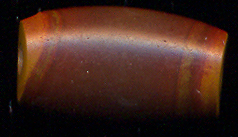
IV 28 - 18 * 10 * 7 mm
Price: 900 usd
|
 |
|
|
|
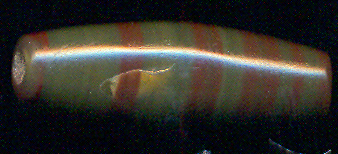
IV 29 - 27 * 9 mm
Price: 1000 usd
|
 |
A soft motif made of dark red and green colors.
Very very rare agate bead. |
|
|
|
|
|
|
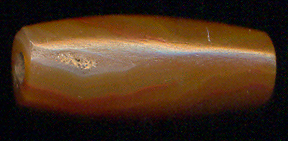
IV 31 21 * 9 mm
Price: 600 usd |
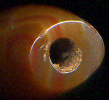 |
|
|
|
|
|
|

IV 32 - 23 * 7 mm
Price: 1000 usd |
 |
Tubularly shaped bead |
|
|
|
|
|
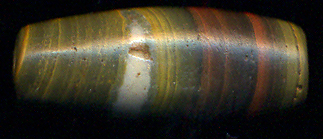
IV 33 - 25 * 10 mm
Price: 1200 usd
|
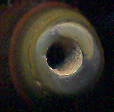 |
Note the red colour in a wonder banded display of
five different colours! |
|
|
|
|
|
|
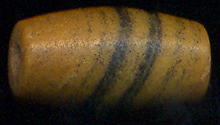
IV 34 - 15 * 10 mm
Price: 600 usd |
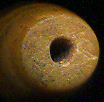 |
|
|
|
|
|
|
|
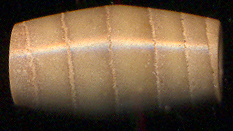
IV 35 - 18 * 10 mm
Price: 900 usd |
 |
In this awesome bead it is clear to
see how the etching of beads was an attempt to copy mother nature. |
|
|
|
|
|
|
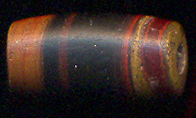
IV 36 - 14 * 8 mm
- SOLD |
 |
On this rare ancient bead you will find
four different versions of red color! |
|
|
|
|
|
|
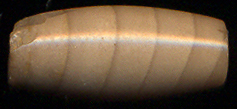
IV 37 - 18 * 8 mm
SOLD |
 |
Mother nature's natural banding. Look at
the hole of this bead...
Almost no bead artists in the
later periods
could make
such holes! |
|
|
|
|
|
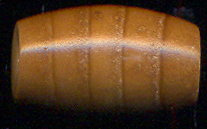
IV 38 - 15 * 10 mm
Price: 900 usd
|
 |
|
|
|
|
|
|
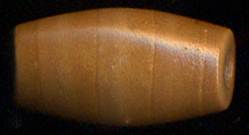
IV 39 - 19 * 10 mm
Price: 900 usd |
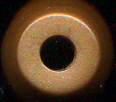 |
|
|
|
|
|
|
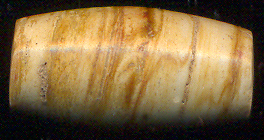
IV 40 - 20 * 11 mm
Price: 900 usd |
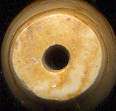 |
|
|
|
|
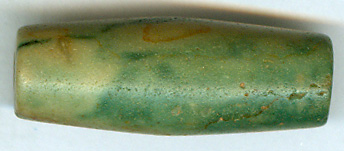
IV 40
Price: 900 usd
|
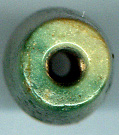 |
Rare amazonite from Gujarat or Orissa |
|
|
|
|
|
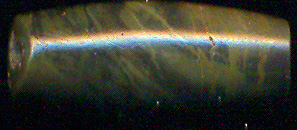
IV 41
Price: 1000 usd |
 |
|
|
|
|
|
|
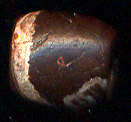
IV 43 - 9 * 7 mm
Price: SOLD
|
 |
|
|
|
|
|
|
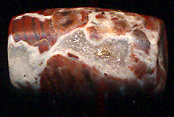
IV 41 - - 13 * 9 mm
Price: 900 usd
|
 |
In this bead you can see
formations of crystal quartz |
|
TRANSLUCENT INDUS VALLEY/ EARLY CLASSIC PERIOD BEADS
The beauty of translucent beads
is a bit difficult to display on a website. Unfortunately, it is
impossible to capture the real shine of a translucent bead.
The 3-dimensional
luster can only be experienced when you have the bead in
your hand. Still, I hope you can get a glimpse of the magic shine
emanating from these ancient beads! The translucent shine of the
bead
TIVB 2 has not
diminished in over 3000 years!
Many of these beads have not been heat treated.
A beautiful bead is a messenger transcending time
As you look through the stone you pierce through time. The same shine that has captivated
the bead makers in the golden Indus Valley still
shines bright even today!
A timeless bond between you and your ancestors living countless
generations before you is established in this fascination of
translucent bead-beauty.
|
|
|
'Cooked' Multi Colored Translucent Banded Agate Beads
|
|
|

IV-TL 2 - 24
* 6 mm
Price: 1100 usd |
 |
Click on picture for larger image |
|
|
|
|
|
|
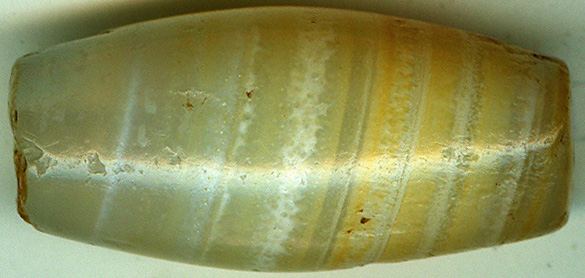
IV-TL 5 - 22 *
11 mm
Price: 700 usd |
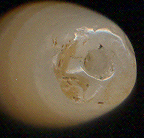 |
|
|
| |
|
|
|
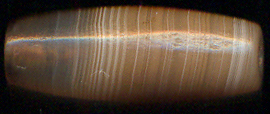
IV-TL 6 -
21 * 8 mm
Price: 750 usd |
 |
|
|
| |
|
|
|
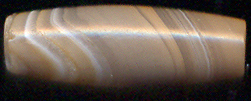
IV-TL 8 - 20 * 7 mm
Price: 900 usd |
 |
|
|
|
|
|
|
|
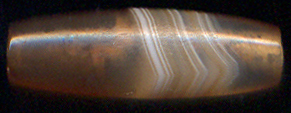
IV-TL 9 -
23 * 7 mm
Price: 1000 usd
|
 |
|
|
| |
|
|
|
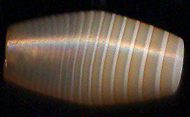
IV-TL 10
- 15 * 8 mm
Price: 900 usd |
 |
|
|
| |
|
|
|
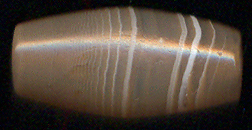
IV-TL 11 - 19 * 10 mm
Price: 950 usd
|
 |
|
|
| |
|
|
|
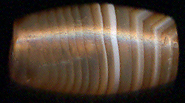
IV-TL 12 - 14 * 7 mm
Price: 800 usd |
 |
|
|
|
|
|
|
|
|
THE FLATTENED INDIAN BEAD
According to Horace Beck the flattened bead is an Indian
invention:
Another very curious feature of the Indian bead is that so
many of the regular forms are flattened, the circular section
becoming an irregular one with two sides much greater than the
other.
(Beads of Taxila p.8)
In the following display, you will observe a lot of flattened
beads.
'Cooked', heat treated flat shaped translucent
Carnelian Beads
The next series is showing heat treated lenticular beads. The deep carnelian color is not so dominant in these beads.
Maybe they were only heat treated through repeated sun exposure.
|
|
|
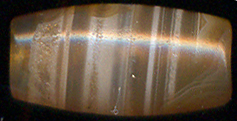
IV-C 1 - 19 * 10 * 8 mm
Price: 900 usd |
 |
|
|
| |
|
|
|
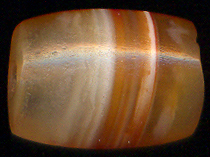
IV-C 2
- 16 * 12 * 7 mm
Price: 800 usd |
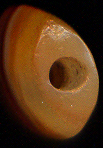 |
|
|
| |
|
|
|
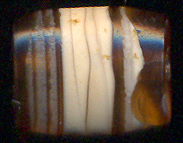
IV-C 3
- 13 * 11 * 5 mm
Price: 700 usd |
 |
|
|
| |
|
|
|
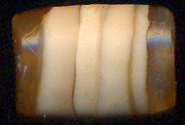
IV-C 4 - 14 * 10 * 5 mm
Price: 800 usd |
 |
|
|
| |
|
|
|
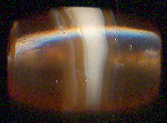
IV-C 5 - 12 * 9 * 6 mm
Price: 600 usd |
 |
|
|
|
|
|
|
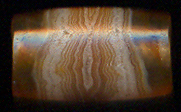
IV-C 6
- 14 * 8 * 5 mm
Price: 850 usd |
 |
|
|
|
|
|
|
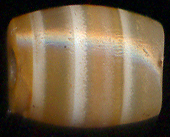
IV-C
7
- 13 * 10 * 5 mm
Price: 900 usd
|
 |
|
|
|
|
|
|
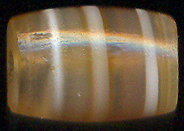
IV-C
8
- 13 * 10 * 7 mm
Price: 900 usd |
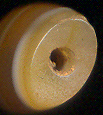 |
|
|
|
|
|
|
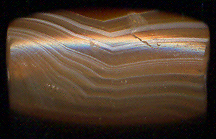
IV-C
9
- 17 * 10 * 6 mm
Price: 900 usd
|
 |
|
|
|
|
|
|
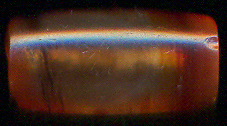
IV-C 1O - 18 * 10 * 5 mm - SOLD |
 |
|
|
| |
|
|
|
|
|
|
|
|
Flat shaped
multicolored variegated jasper |
| |
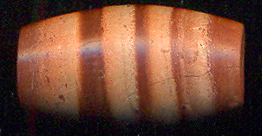
IV-F 1
- 19 * 11 * 8 mm
Price: 1000 usd |
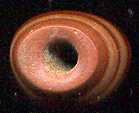 |
|
|
|
|
|
|
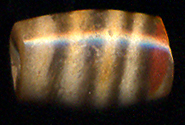
IV-F 2
- 13 * 8 * 6 mm
Price: 1000 usd |
 |
|
|
|
|
|
|
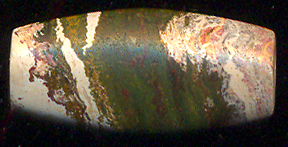
IV-F 3
- 23 * 11 * 5 mm -SOLD |
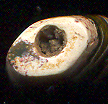 |
|
|
|
|
|
|
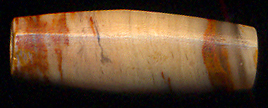
IV-F 4 - 21 * 6 * 5 mm
Price: 1000 usd |
 |
|
|
|
|
|
|
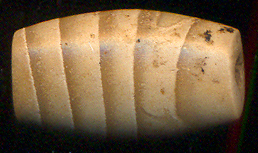
IV-F 5
- 19 * 11 * 7 mm
Price: 900 usd |
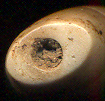 |
|
|
| |
|
|
|
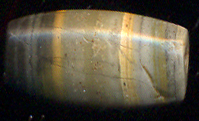
IV-F 6 - 15 * 8 * 5 mm
Price: 1000 usd |
 |
|
|
| |
|
|
|
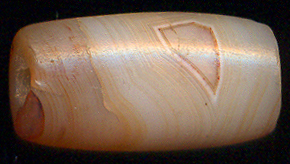
IV-F 7
- 22 * 12 * 8 mm
Price: 1000 usd
|
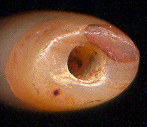 |
|
|
| |
|
|
|
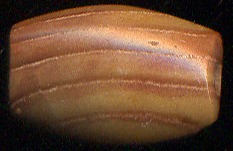
IV-F 8 - 17 * 12 * 8 mm
Price: 900 usd
|
 |
|
|
| |
|
|
|
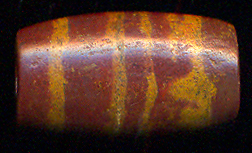
IV-F 9 - 18 * 11 * 7 mm
Price: 1000 usd |
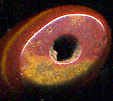 |
|
|
|
|
|
|
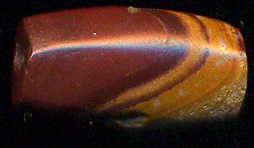
IV-F
10 - 18 * 11 * 6 mm
Price: 900 usd |
 |
|
|
|
|
|
|
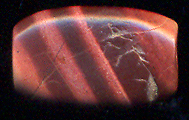
IV-F 13 - 14 * 9 * 4 mm
Price: 900 usd
-Highly unusual color |
 |
|
|
|
|
|
|
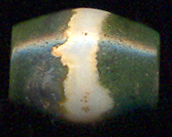
IV-F 14 - 13 * 10 * 7 mm
Price: 800 usd |
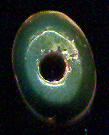 |
SOLD |
|
ANCIENT 'WHITE MAGIC' BEADS
Beads in all
form and shapes
The ancient Indus Valley people went to great efforts to obtain
agate stones for making beads of right colors, shapes, and sizes.
Among all these shapes the flatly shaped beads are among the most
interesting -
especially the lenticular shaped ones.
Lesser cooked beads make the task of chipping the beads into shape more difficult!
On top of it many of the beads in this series are translucent.
Unfortunately, the luster of
'uncooked' - not heat treated - carnelian is difficult to
display through a photo scan.
Still I am sure you will enjoy the mastery of the ancient bead
makers.
THE WHTE COLOR OF PURITY
As you can observe, these beads have the white color in common.
White was and is a holy color in Buddhism. Are these beads
Buddhist beads? As stated on
a different page on
this site there is a yet unexplored link
between the Indus Culture and the early Buddhist culture.
As previous stated, these beads here present an historical
overlap between the Indus culture and the early classical
period. The early classical time also called the second
urbanisation period is the time of the rising of the
Buddha! Many of these beads may very well have been amulets and
protectors of the early Buddhist.
Note here the white color on the beads. This is not a coincidence. These beads are made with white design
deliberately.
The true color of Buddhism?
In Tibetan Buddhism, the
black sulemani beads have become synonymous with Buddhist talismanic
power. Especially the Chinese prefer to copy this trend.
However I dare to say that white was and still is the
true Buddhist color!
In Tibetan Buddhism there is a strong element of Bön, the
original shamanistic and animistic belief systems prevalent
before Buddhism arrived in Tibet. Buddhism was now, as the case
is in many other Buddhist cultures, constructed as a layer upon
what was already there.
Let me sum it up in a thought provoking way:
White is the true pure color of Buddhism...
Black might rather belong to the
'dark' magic of the Bön shamans.
|
|
'Uncooked', white lenticular shaped translucent carnelian
Beads |
| |
|
|
|
| |
|
|
|
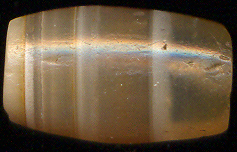
IV-U 2 - 19 * 12 * 7 mm
Price: 1000 usd |
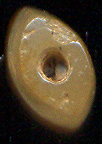 |
|
|
| |
|
|
|
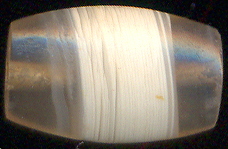
IV-U 3 - 18 * 12 * 5 mm
Price: 1000 usd |
 |
|
|
| |
|
|
|
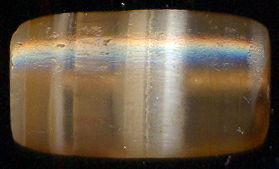
IV-U 4
- 22 * 13 * 6 mm
Price: 1000 usd |
 |
|
|
| |
|
|
|
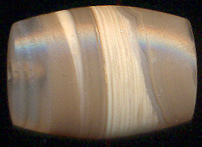
IV-U 5 - 15 *
11 * 6 mm
Price: 900 usd |
 |
|
|
| |
|
|
|
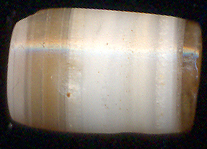
IV-U 6
- 17 * 10 * 6 mm
Price: 900 usd |
 |
|
|
| |
|
|
|
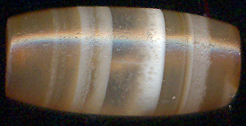
IV-U
7 - 19 * 10 * 8 mm
Price: 900 usd
|
 |
|
|
| |
|
|
|
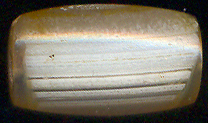
IV-U 8 - 16 * 10 * 8
mm - SOLD |
 |
|
|
| |
|
|
|
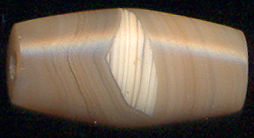
IV-U
9 - 19 * 10 * 7 mm
Price: 1200 usd
|
 |
|
|
| |
|
|
|
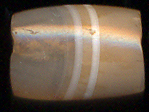
IV-U 10- 11 * 8 * 5 mm
Price: 700 usd
|
 |
|
|
| |
|
|
|
|
Translucent, uncooked, banded agate - white/grey |
| |
|
|
|
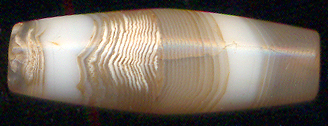
IV-TBA 1
- 26 * 9 mm
Price: 1100 usd |
 |
|
|
|
|
|
|
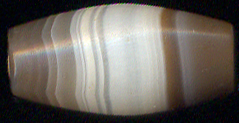
IV-TBA 2
- 19 * 10 mm
Price: 1000 usd |
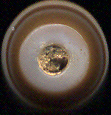 |
|
|
|
|
|
|
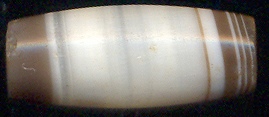
IV-TBA 3 - 21 * 9 mm
Price: 1100 usd |
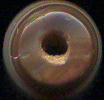 |
|
|
| |
|
|
|
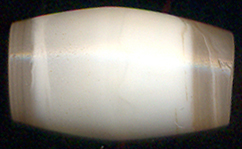
IV-TBA 4
- 18 * 12 mm
Price: 1100 usd
|
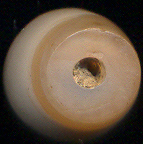 |
|
|
| |
|
|
|
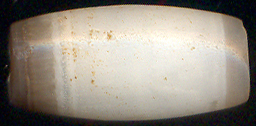
IV-TBA 5
- 20 * 10 mm
Price: 1100 usd |
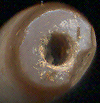 |
|
|
|
|
|
|
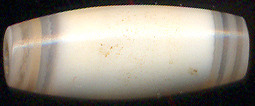
IV-TBA 6 - 21 * 8 mm
Price: 1100 usd |
 |
|
|
|
|
|
|
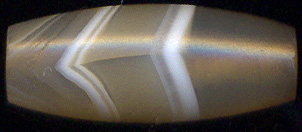
IV-TBA 7 - 25 * 10 mm
Price: 900 usd
|
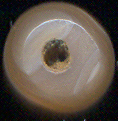 |
|
|
| |
|
|
|
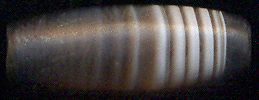
IV-TBA 8 - 20 * 7 mm
Price: 1100 usd |
 |
|
|
| |
|
|
|
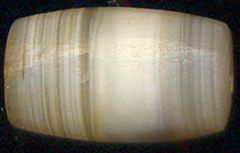
IV-TBA 9
- 19 * 12 mm
Price: 900 usd |
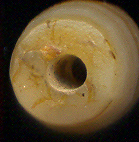 |
|
|
|
|
|
|
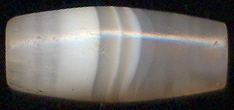
IV-TBA 10 - 19 * 9 mm
Price: 900 usd |
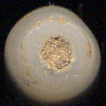 |
|
|
|
|
|
|

IV-TBA 11 - 21 * 5 mm
Price: 1000 usd |
 |
|
|
| |
|
|
|

IV-TBA 12
- 21 * 7 mm
Price: 1100 usd |
 |
|
|
| |
|
|
|

IV-TBA 13 - 22 * 7 mm
Price: 1000 usd |
 |
|
|
| |
|
|
|
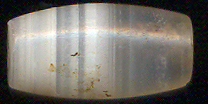
IV-TBA 14
- 15 * 8 mm
Price: 900 usd
|
 |
|
|
| |
|
|
|
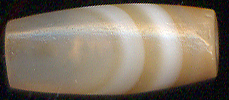
IV-TBA 15
- 18 * 8 mm
Price: 800 usd
|
 |
|
|
|
|
|
|

IV-TBA 17 - 12 * 6 mm
Price: 600 usd |
 |
|
|
| |
|
|
|

IV-TBA 18
- 18 * 6 mm
Price: 1000 usd |
 |
|
|
|
|
|
|
|
|

IV-OIV
16 -
A unique translucent pendant bead
Price: 800 usd
|
|
|